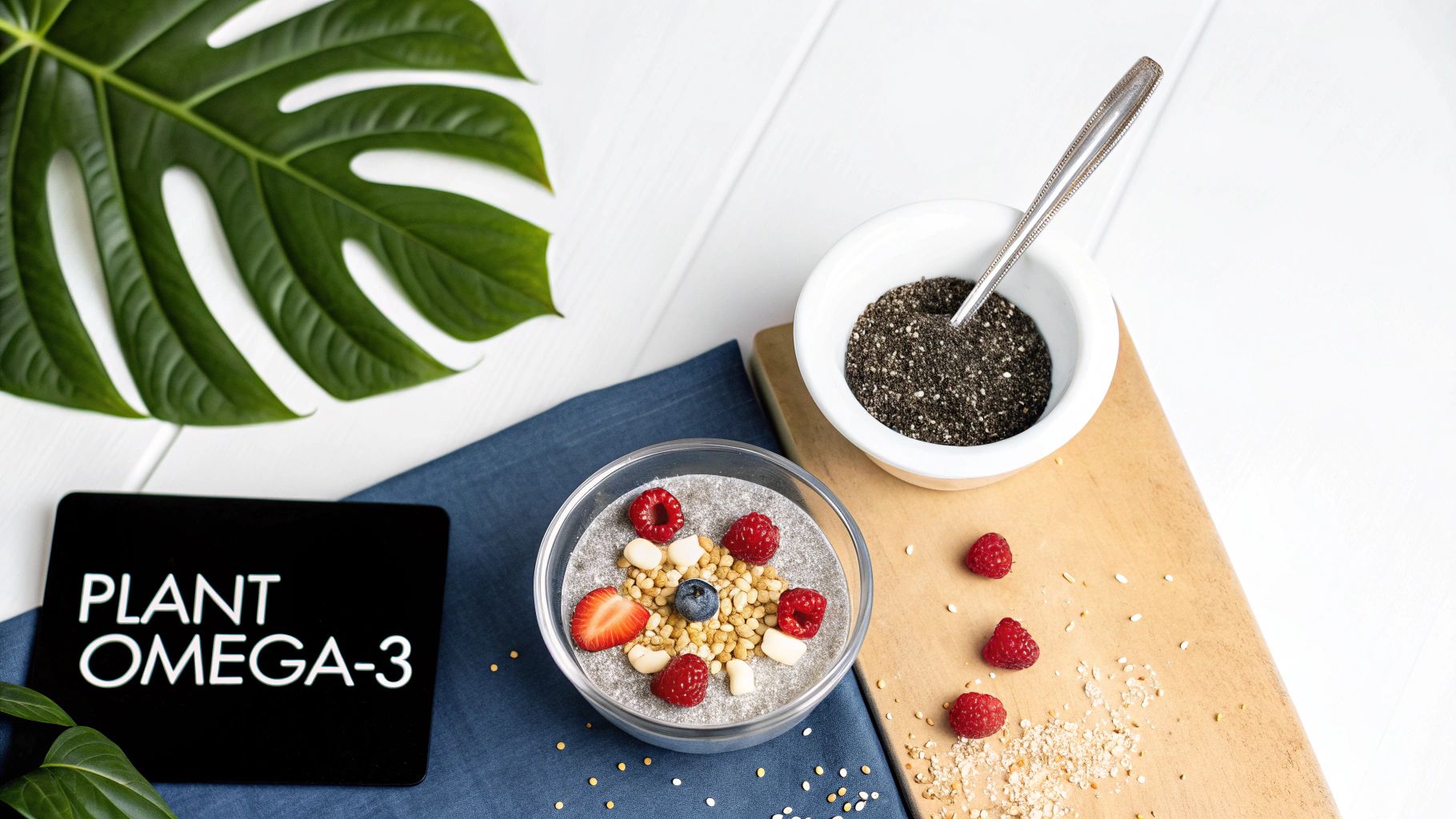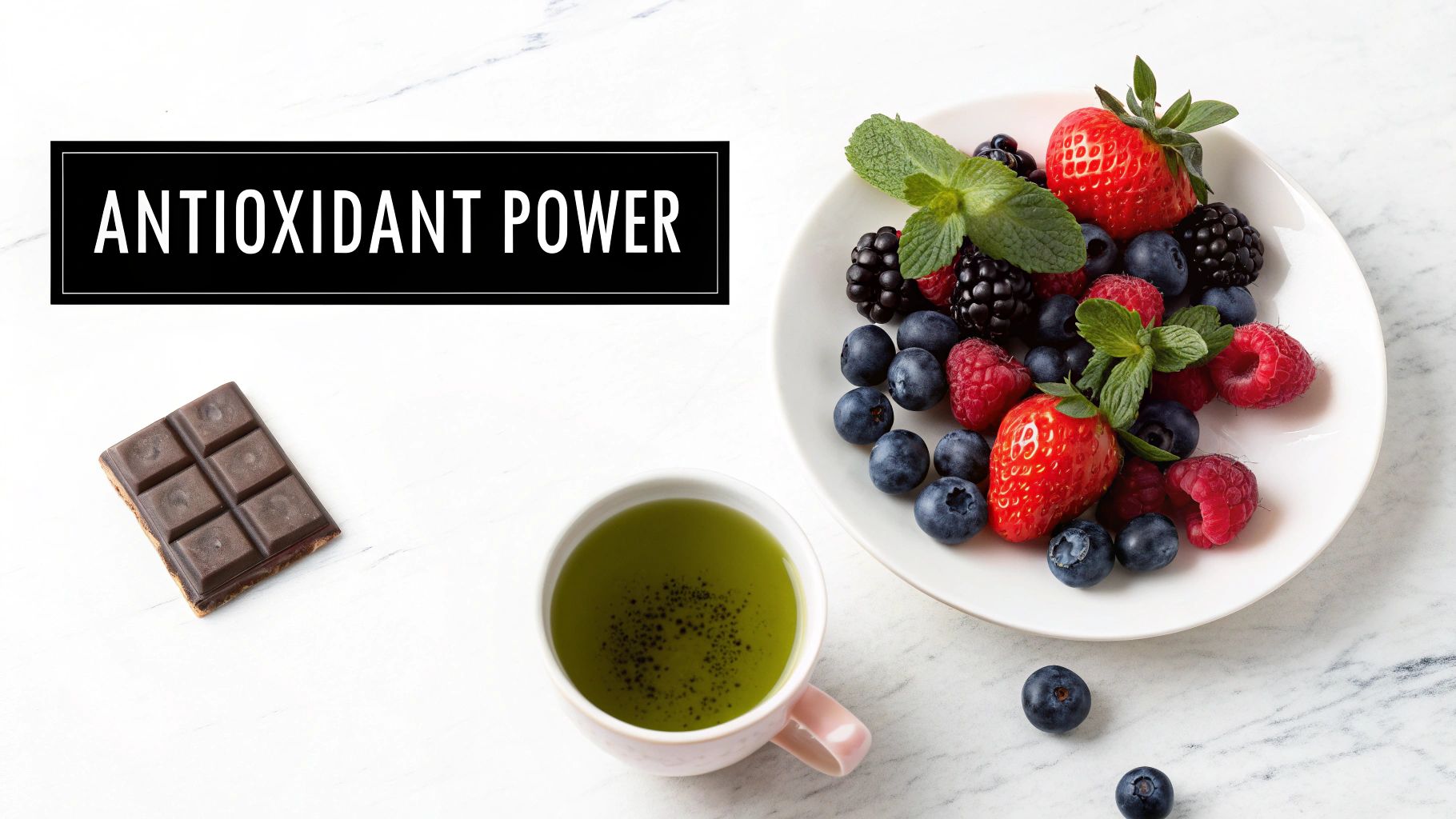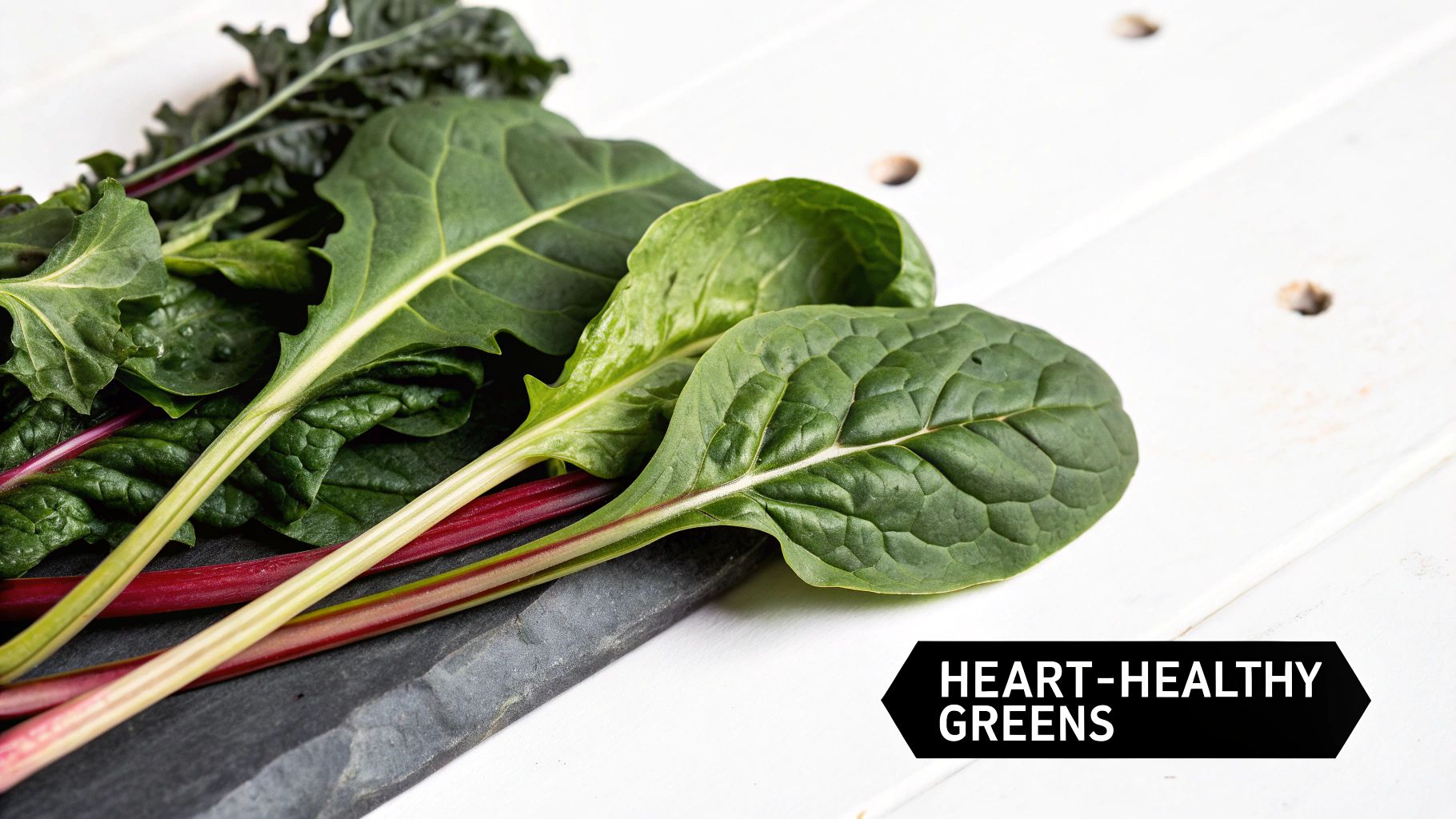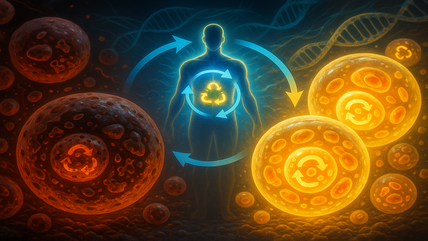You've probably seen apple cider vinegar (ACV) touted as a cure-all, but what's actually in the bottle? Before we get into the potential benefits, let's break down what this popular health tonic really is.
What Exactly Is Apple Cider Vinegar?
At its heart, ACV is just fermented apple juice. The process is a simple, two-step journey that turns the natural sugars in apples into the sharp, tangy liquid you know. It's a lot like making sourdough or brewing kombucha.
First, crushed apples are mixed with yeast. The yeast eats the sugar and ferments it into alcohol. Next, beneficial bacteria are introduced, which continue the fermentation process, converting the alcohol into acetic acid. This acid is the main active compound in vinegar and is thought to be the engine behind most of its health properties.
Unfiltered vs. Filtered ACV
When you're shopping for ACV, you'll see two main types on the shelf: the crystal-clear, filtered kind and the cloudy, unfiltered version. There's a key difference.
- Filtered ACV: This type is sparkling clear because it's been pasteurized and processed to remove all the sediment. While it’s perfectly fine for cooking, it’s missing "the mother."
- Unfiltered ACV: This is the raw, unpasteurized stuff. It looks cloudy because it contains that web-like stuff floating inside, known as "the mother." This is a colony of beneficial bacteria, proteins, and enzymes that form during fermentation.
Most health enthusiasts reach for the raw, unfiltered variety. The thinking is that "the mother" contains probiotics and other compounds that contribute to ACV's benefits. This lines up with what we're learning about how fermented foods can support our well-being. If you're curious about this, you can learn more about the connection between fermented foods and longevity in our detailed guide.
The Power of Acetic Acid
The real star of the show in apple cider vinegar is acetic acid. It’s what gives ACV its potent sour taste and strong smell, but its role goes way beyond flavor. Scientists believe this short-chain fatty acid can influence several important processes in the body.
Acetic acid is thought to slow down the rate at which food leaves the stomach. This action can help you feel fuller for longer and may play a role in managing blood sugar spikes after a meal.
This mechanism is central to many of the health claims you hear about. Once you grasp this foundational idea—that a simple acid from fermented apples can have this kind of effect—the benefits we'll discuss later make a lot more sense. It’s not magic; it’s biochemistry at work.
Exploring the Science-Backed Health Benefits
Apple cider vinegar has built a massive reputation as a wellness powerhouse, but it's crucial to separate the real, science-backed claims from the wellness myths. While it's certainly not a magic bullet, a growing body of research points to several tangible benefits, mostly driven by its active ingredient, acetic acid.
Let's dive into what the actual evidence says about ACV's role in everything from weight management and blood sugar control to gut health. The journey from apple to vinegar is a simple, natural one, involving a two-step fermentation that creates the acetic acid and beneficial bacteria known as "the mother."
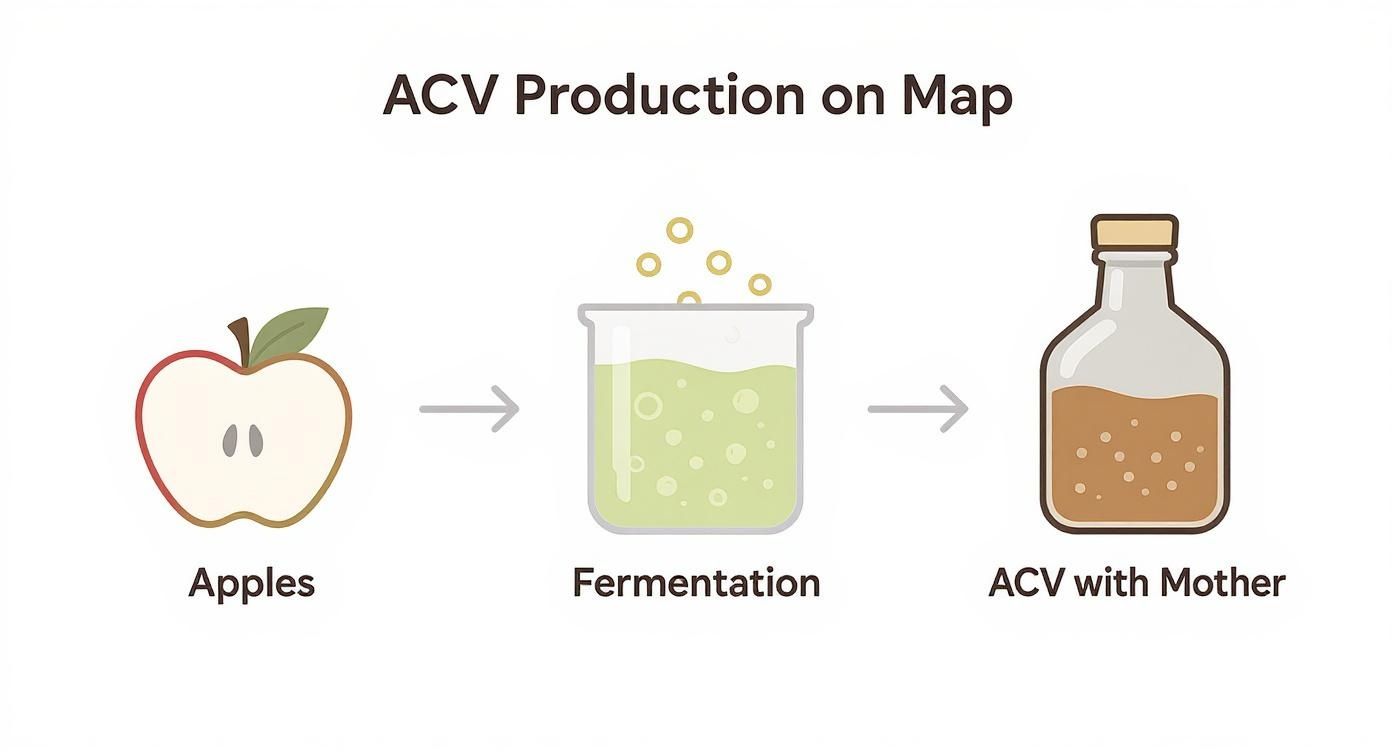
This process is what turns simple apple juice into the potent liquid so many people add to their daily routines.
Aiding in Weight Management
One of the most talked-about benefits is ACV's potential to support weight management. It's not a fat-melting potion, but it seems to work by promoting a feeling of fullness, or satiety. Think of the acetic acid as a gentle brake on your digestion, slowing down how quickly food leaves your stomach.
This delay means you feel full for longer after you eat. The ripple effect? You might naturally eat fewer calories over the course of the day. A few studies have shown that when people took ACV with a high-carb meal, they felt significantly more full and ended up eating 200-275 fewer calories later on. While modest, that can be a helpful tool when paired with a balanced diet and regular exercise.
Supporting Healthy Blood Sugar Levels
Another area with solid research is ACV's effect on blood sugar and insulin sensitivity. This is especially relevant for anyone managing prediabetes or type 2 diabetes, but it can also help the rest of us avoid those sluggish energy crashes after a carb-heavy lunch.
The main mechanism here seems to be acetic acid’s ability to partially block the enzymes that digest starches. Imagine these enzymes are like tiny scissors snipping complex carbs into simple sugars. ACV appears to dull the scissors, meaning fewer sugars get absorbed into the bloodstream all at once.
This results in a smaller, less dramatic spike in blood glucose after eating. For people with insulin resistance, this effect can improve how their cells respond to insulin over time, making it easier to manage blood sugar levels.
These benefits have helped drive ACV's demand in health-conscious markets worldwide. Clinical studies have made it a popular ingredient in wellness products, and you can read more about the analysis of ACV's global impact to see the trends.
Promoting a Healthy Gut Environment
While the research is still developing, apple cider vinegar may also support digestive health. As a fermented product, raw and unfiltered ACV contains beneficial bacteria from "the mother." These good microbes, or probiotics, are the foundation of a healthy gut microbiome.
On top of that, ACV has natural antimicrobial properties. Its acidity can help slow the growth of unwanted pathogens like E. coli. It won't cure an infection, but it might help maintain a healthier balance of bacteria in your digestive system.
A balanced gut is critical for more than just digestion—it influences your immune system and even your mental health. This becomes especially important as we get older, a topic we cover in our guide on the connection between gut health and aging.
Potential Skin and Antimicrobial Benefits
Beyond what you drink, ACV has a long history as a topical treatment and natural disinfectant. Its benefits for skin and cleaning stem from its acidity and antimicrobial nature.
- Balancing Skin pH: Our skin is naturally slightly acidic. Using a very diluted ACV solution as a toner can help restore this balance, especially if you use alkaline soaps.
- Managing Acne: The antibacterial effects of acetic acid may help fight the bacteria that contribute to breakouts. When applied carefully, it can act as a gentle exfoliant.
- Antifungal Properties: Studies show ACV can inhibit the growth of fungi like Candida albicans, making it a popular home remedy for things like athlete's foot.
It is absolutely critical to heavily dilute ACV before ever putting it on your skin to avoid chemical burns. A safe starting point is a 1-to-10 ratio of ACV to water.
To put it all in perspective, here’s a quick-reference table summarizing the main health claims for apple cider vinegar and where the science currently stands on each.
Summary of Key Apple Cider Vinegar Benefits and Evidence Level
| Claimed Benefit | Potential Mechanism | Level of Scientific Evidence |
|---|---|---|
| Weight Management | Increases satiety and delays stomach emptying, leading to reduced calorie intake. | Moderate: Supported by several small to medium human studies. |
| Blood Sugar Control | Improves insulin sensitivity and slows the digestion of starches after meals. | Strong: One of the most well-researched benefits, with consistent findings. |
| Gut Health | Acts as a prebiotic and contains probiotics ("the mother"); antimicrobial properties. | Promising: Some supportive evidence, but more human trials are needed. |
| Skin Health (Topical) | Balances skin pH and has antibacterial properties that may help with acne. | Limited: Mostly anecdotal evidence; requires extreme caution due to acidity. |
| Antimicrobial Agent | Acetic acid can kill or inhibit the growth of various pathogens. | Strong (in vitro): Proven in lab settings; practical application varies. |
This table shows that while some benefits are quite promising and backed by good evidence, others are still in the early stages of research. It highlights where ACV is most likely to deliver results and where more investigation is needed.
How to Use Apple Cider Vinegar Safely

It’s one thing to hear about the potential benefits of apple cider vinegar, but how you use it is just as important as why. Because of its high acidity, ACV isn’t something you can just chug straight from the bottle. Think of it like a potent spice—a little goes a long way, and you wouldn't eat it by the spoonful.
The key to unlocking its advantages without the downsides lies in safe, consistent habits, not high doses. Your biggest rule? Always dilute apple cider vinegar. Drinking it neat can do real damage to your tooth enamel and the delicate lining of your throat and esophagus.
This simple step is non-negotiable for safe use, making the potent liquid much gentler on your body while still delivering its active compounds.
Proper Dosing and Dilution
For most people, a safe and effective daily dose is 1 to 2 tablespoons (15-30 ml). If you’re just starting, it’s a good idea to begin with a smaller amount, like one teaspoon, and see how your body responds before gradually working your way up.
Here’s the golden rule for dilution:
- Mix 1–2 tablespoons of ACV into a large glass of water (at least 8 ounces or 240 ml).
- Always give it a good stir before drinking to make sure the acid is evenly distributed.
This simple practice is your best defense against potential side effects. By heavily diluting ACV, you buffer its acidity, making it safe for your teeth and throat while still reaping the internal benefits.
Easy Ways to Add ACV to Your Routine
The thought of drinking vinegar might not sound too appealing, but folding it into your daily life can be surprisingly easy and even tasty. Consistency matters more than the exact time of day, so find a method you genuinely enjoy and can stick with.
For Drinking:
- Morning Tonic: Start your day by mixing 1 tablespoon of ACV into a large glass of warm water. A squeeze of lemon or a tiny bit of raw honey can make it much more palatable.
- Pre-Meal Drink: Taking your diluted ACV mixture about 15–30 minutes before a meal may help you feel fuller and can help blunt the blood sugar spike that follows a carb-heavy meal.
- Herbal Tea Infusion: Stir a teaspoon of ACV into a mug of chamomile or ginger tea. The flavors actually blend quite well, creating a soothing and beneficial drink.
Best Practices for Topical Use
The benefits of ACV aren’t just internal. Its antimicrobial and pH-balancing properties can be great for skin and hair, but the dilution rule is even more critical here. Putting undiluted ACV directly on your skin can cause irritation or even chemical burns.
Here are a few safe ways to use it on your skin and hair:
- Facial Toner: Create a very gentle toner by mixing 1 part ACV with 10 parts water. Apply it with a cotton pad after cleansing, and always follow up with a moisturizer.
- Hair Rinse: For a clarifying rinse that removes product buildup and adds shine, mix 2–3 tablespoons of ACV into a large bottle of water. After shampooing, pour the mixture over your hair, let it sit for a minute or two, and then rinse it out thoroughly.
Ultimately, using ACV safely means respecting its potency. In this case, more is definitely not better. By following these simple guidelines for dilution and dosage, you can confidently make it a part of your wellness toolkit.
Of course, here is the rewritten section with a more human, expert-driven tone, following all your specific instructions.
Understanding the Potential Risks and Side Effects
While it’s easy to get excited about the benefits of apple cider vinegar, it’s a potent substance that deserves a balanced perspective. Like any powerful tool, ACV needs to be handled with respect for its properties—especially its high acidity.
Understanding the potential risks and side effects is the key to using it safely and effectively. Ignoring the downsides can lead to anything from mild discomfort to more serious problems. The good news? Most of these risks are easy to manage with proper dilution and mindful use. Once you know the precautions, you can confidently decide if ACV is the right fit for your routine.
The growing popularity of ACV isn't just a fleeting trend; it reflects a major shift toward natural wellness solutions. The global apple cider vinegar market was valued at around USD 723.5 million in 2025 and is projected to hit USD 1,259.5 million by 2035. You can get more insights on this growing market over at Future Market Insights.
The Risk of Tooth Enamel Erosion
One of the most significant and well-documented side effects of ACV is its potential to damage tooth enamel. The very thing that gives ACV its benefits—acetic acid—is also corrosive by nature. Think of it like a very mild version of the acid used to clean metal; over time, it can wear away protective surfaces.
When you drink ACV undiluted, that acid comes into direct contact with your teeth. Regular exposure can soften and dissolve the enamel, which is the hard outer layer protecting your teeth from decay. Once that enamel is gone, it doesn't grow back.
A few simple habits can protect your smile while still letting you enjoy ACV:
- Always Dilute It. Never drink ACV straight. A good rule of thumb is 1–2 tablespoons mixed into a full glass of water.
- Use a Straw. Sipping through a straw helps the liquid bypass most of your teeth, minimizing direct acid contact.
- Rinse Afterward. After you’re done, swish your mouth with plain water to wash away any lingering acid.
- Wait to Brush. Avoid brushing your teeth for at least 30 minutes after drinking ACV. The acid temporarily softens your enamel, and brushing right away can scrub it off.
Digestive Discomfort and Other Concerns
For some people, apple cider vinegar can cause some digestive upset. Because it can slow down the rate at which your stomach empties its contents, it might lead to feelings of nausea, indigestion, or bloating, especially if you take too much.
If you have a history of gastroparesis—a condition where the stomach empties too slowly—using ACV could make your symptoms worse. It's essential to start with a tiny dose, like one teaspoon in a large glass of water, just to see how your system handles it.
And because it’s so acidic, drinking undiluted ACV can cause irritation or even chemical burns to the delicate tissues in your throat and esophagus. This is exactly why the rule of dilution is non-negotiable.
Potential Medication Interactions
Perhaps the most critical thing to consider is how ACV might interact with certain medications. Its effects on blood sugar and potassium levels mean that anyone on specific prescriptions needs to be cautious and talk to their doctor first.
Key Interactions to Be Aware Of:
- Diabetes Medications: ACV can lower blood sugar levels. If you combine it with insulin or other diabetes drugs, you run the risk of your blood sugar dropping too low (hypoglycemia). Your doctor might need to adjust your medication dosage.
- Diuretics (Water Pills): Certain diuretics cause the body to lose potassium. Since large amounts of ACV might also lower potassium, the combination could lead to a significant drop, affecting heart and muscle function.
- Digoxin (Lanoxin): This heart medication is also sensitive to potassium levels. Taking it alongside ACV could amplify its side effects.
Making an informed choice means looking at both sides of the coin. Acknowledging these risks empowers you to use apple cider vinegar responsibly, making sure it stays a helpful part of your wellness routine instead of a source of new problems.
How to Choose the Best Apple Cider Vinegar

Walking down the health food aisle can feel a bit overwhelming. You’ll see shelves packed with apple cider vinegar options, from crystal-clear liquids to murky concoctions and even gummies. How do you know which one is actually worth your money?
Luckily, it's simpler than it looks. Once you know how to read the labels like a pro, you can easily spot the good stuff. The key is understanding that not all ACV is created equal, and the way it’s processed makes all the difference.
Look for Raw and Unfiltered with The Mother
If there’s one phrase to remember, it’s this: "raw, unfiltered, and containing 'the mother'." This isn't just clever marketing; it’s your best indicator of a high-quality, minimally processed vinegar.
- Raw: This tells you the vinegar hasn't been pasteurized (heated to high temperatures). Pasteurization can kill off the beneficial bacteria and enzymes that develop during fermentation.
- Unfiltered: An unfiltered product will look cloudy and might have some sediment settled at the bottom. That's a good thing! It means the most valuable part is still in there.
- "The Mother": This is that web-like stuff floating inside. It's a colony of beneficial bacteria, proteins, and enzymes, and many of ACV's potential benefits are attributed to these compounds. Filtered versions remove it completely.
Choosing an ACV with these labels ensures you're getting it in its most natural and potent state.
Organic vs. Conventional Options
Next, you’ll probably see both organic and conventional ACV. An organic label guarantees the apples used to make the vinegar were grown without synthetic pesticides or fertilizers, which is a big plus for many people.
This preference for cleaner ingredients is a powerful market force. In fact, organic ACV is growing at an estimated rate of 9.83% annually through 2030, outpacing conventional options as shoppers increasingly seek out certified natural products. You can discover more about these consumer trends in the ACV market.
Liquid vs. Gummies and Capsules
Lately, ACV gummies and capsules have exploded in popularity, promising the benefits without the sour taste. While they’re certainly convenient, they often come with trade-offs.
Many ACV gummies contain added sugars, artificial flavors, and fillers to make them taste good. This can counteract some of the very health goals you're trying to achieve, like better blood sugar management.
Liquid ACV is the purest and most traditional form, giving you full control over your dose without any hidden additives. Capsules are a better alternative to gummies if you can't stand the taste, but always check the ingredient list for unnecessary fillers.
Ultimately, opting for the classic liquid form aligns better with a whole-foods approach to wellness. To dive deeper into this, check out our guide on ultra-processed vs. whole foods. Being a confident consumer means choosing the product that best supports your health, not just your taste buds.
Have Questions About ACV? We Have Answers.
It's totally normal to have a few lingering questions, even after you've got the basics down. Let's run through some of the most common ones that come up, so you can move forward with confidence.
Think of this as your final checklist. We'll cover everything from how long it really takes to see results to the great gummies vs. liquid debate.
How Long Does It Take to See Benefits?
This is the big one, and the honest answer is: it depends. The timeline for seeing any real change from apple cider vinegar varies based on your body, your lifestyle, and what you’re trying to achieve in the first place. ACV isn't an overnight fix; it's a tool for gradual support.
- For Blood Sugar: Some effects are pretty quick. You might notice a smaller glucose spike after a carb-heavy meal within the first few times you use it.
- For Weight Management: These benefits are cumulative. Feeling a bit fuller after meals might happen right away, but any change on the scale is more likely to take several weeks or even a few months of consistent use, alongside a healthy diet and exercise.
The key here is patience and consistency. Think of ACV as one small, supportive habit, not a magic bullet. Giving it at least 8 to 12 weeks of daily use is a realistic window to see how your body responds.
Can I Drink Apple Cider Vinegar Straight?
Let's make this simple: absolutely not. Drinking ACV undiluted is one of the biggest and most dangerous mistakes you can make. The acetic acid is strong enough to cause real harm.
Taking it straight from the bottle can lead to:
- Chemical burns in your mouth, throat, and esophagus
- Serious damage to your tooth enamel
- Worsening of acid reflux or stomach ulcers
Always, always follow the golden rule of ACV: dilute, dilute, dilute. Mixing one to two tablespoons into a large glass of water (at least 8 ounces) is the only safe way to drink it. That simple step protects your body while still letting you get the benefits.
Is ACV Safe for Everyone?
While ACV is generally safe for most healthy adults when used correctly, it’s not for everyone. Certain health conditions and medications can create some risky interactions.
You should definitely talk to your doctor before trying ACV if you:
- Have Type 1 or Type 2 Diabetes: Because ACV can lower blood sugar, it might interfere with insulin or other medications, meaning your dosage might need an adjustment.
- Take Diuretics or Heart Medications: ACV can affect potassium levels, which is a big deal for anyone on drugs like diuretics or digoxin.
- Have Gastroparesis: ACV slows stomach emptying, which can make the symptoms of this condition worse.
- Have Low Potassium Levels (Hypokalemia): ACV could lower potassium even further, which can be dangerous.
- Are Pregnant or Breastfeeding: There just isn’t enough research to know if it’s safe, so it’s best to play it safe and avoid it.
For these groups, getting medical advice isn't just a suggestion—it's a critical safety step.
Are ACV Gummies as Good as the Liquid?
ACV gummies have exploded in popularity. They promise all the perks without the sour taste, but are they really an equal swap for the liquid? It’s complicated.
The Pros of Gummies:
- Taste: They're much easier to stomach if you can't handle the harsh taste of vinegar.
- Convenience: They’re easy to carry and don't require any mixing.
The Cons of Gummies:
- Added Sugars: Many brands pack their gummies with sugar, sweeteners, and artificial flavors. This can completely cancel out the very blood sugar benefits you might be looking for.
- Lower Potency: The amount of acetic acid can be all over the place and is often much lower than what you’d get from a standard dose of liquid ACV.
- Missing "The Mother": Most gummies are made from filtered ACV, so they lack the beneficial bacteria and enzymes found in the raw, unfiltered stuff.
For the most potent benefits without junk additives, raw, unfiltered liquid apple cider vinegar is still the gold standard. Gummies are convenient, sure, but you have to read the label carefully and watch out for added sugars that could be working against your health goals.
At Health Digest, we believe in empowering you with clear, science-backed information to make the best choices for your health. Explore our resources to build sustainable, healthy habits that last a lifetime. Discover more at https://healthdigest.blog.
Article created using Outrank











